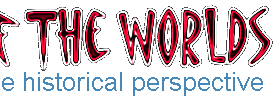The Night that Panicked America (1975)

This is a truly amazing drama, recounting (with an acceptable degree of
artistic license), the behind the scenes making of The War of the Worlds
broadcast and the panic that ensues.
The film is divided into two broad strands. The build up to and broadcast
of the play is a superbly crafted tale, building the tension slowly but surely
and radiating the raw energy and excitement that surely must have distinguished
all the live broadcasts of the time. The other strand, featuring the reactions
of a varied cast of listeners, is slightly less successful, but nonetheless
several of the vignettes succeed in capturing the mixture of bravery and self
delusion that must have characterised many of the real stories that incredible night.
 The film features many key historical any mythological moments. For
instance, the selection of Grover's Mill is recounted, with a slight spin
on the tale. In reality, script writer Howard Koch closed his eyes and
stabbed a pencil down on map brought at a gas station. This time he throws
a dart at a map in
The film features many key historical any mythological moments. For
instance, the selection of Grover's Mill is recounted, with a slight spin
on the tale. In reality, script writer Howard Koch closed his eyes and
stabbed a pencil down on map brought at a gas station. This time he throws
a dart at a map in  the studio office, but the flavour is certainly authentic.
Also featured is the legendary (though surely apocryphal) assault by
residents of Grover's Mill on a water tower, in the mistaken belief that
it was a Martian war machine. the studio office, but the flavour is certainly authentic.
Also featured is the legendary (though surely apocryphal) assault by
residents of Grover's Mill on a water tower, in the mistaken belief that
it was a Martian war machine.
It is however the sense of realism given to the studio scenes that
really carries the film. Paul Stewart, who acted in the original
broadcast and producer John Houseman were technical advisors to the
film, so one can imagine that there is a high degree of authenticity to
the replication of the broadcast. Certainly the sense that such shows
were produced on a wing and a prayer is beautifully captured.
 Wonderful scenes include an actor using a tea cup to simulate the
distorted voice of a bomber pilot talking on a radio, and the reverberating
sound of the Martian cylinder opening, achieved by the unscrewing of a
jamjar in a toilet bowl! It is debatable if this was actually how this
particular effect was achieved, but certainly the person responsible for
the original broadcast sound effects is remembered as someone who could
improvise. Ora Nichols was in fact the only woman SFX engineer Wonderful scenes include an actor using a tea cup to simulate the
distorted voice of a bomber pilot talking on a radio, and the reverberating
sound of the Martian cylinder opening, achieved by the unscrewing of a
jamjar in a toilet bowl! It is debatable if this was actually how this
particular effect was achieved, but certainly the person responsible for
the original broadcast sound effects is remembered as someone who could
improvise. Ora Nichols was in fact the only woman SFX engineer working
in radio and head of the CBS sound department in the 1930's. As the
director of the Buck Rogers radio series once recalled, he and Ora had
on one occasion used an air conditioning vent to simulate the sound of
a roaring rocket engine! working
in radio and head of the CBS sound department in the 1930's. As the
director of the Buck Rogers radio series once recalled, he and Ora had
on one occasion used an air conditioning vent to simulate the sound of
a roaring rocket engine!
 The cast is a varied one, with several early performances by
people who would later become major TV stars. John Ritter (Three's
Company) and Meredith Baxter (Family Ties) both play characters caught
up in the panic, while Happy Days stalwart Tom Bosley turns in a great
role as the harassed studio exec trying to deal with his difficult star,
one Mr Orson Welles. This pivotal role went to Paul Shenar. Alas,
Shenar is now deceased, (he passed away in 1989) The cast is a varied one, with several early performances by
people who would later become major TV stars. John Ritter (Three's
Company) and Meredith Baxter (Family Ties) both play characters caught
up in the panic, while Happy Days stalwart Tom Bosley turns in a great
role as the harassed studio exec trying to deal with his difficult star,
one Mr Orson Welles. This pivotal role went to Paul Shenar. Alas,
Shenar is now deceased, (he passed away in 1989)  but on the evidence of
his performance in this film, and a solid body of subsequent work, he was
an assured actor. Certainly his performance as Welles is full of energy
and one he clearly relished. but on the evidence of
his performance in this film, and a solid body of subsequent work, he was
an assured actor. Certainly his performance as Welles is full of energy
and one he clearly relished.
 Another contribution by a then up and coming movie personality,
this time from behind the scenes, was that of the script by Nicholas
Meyer. Meyer would go on to pen scripts to two of the best Star Trek
movies, and an equally wonderful historical fantasy featuring a lead
character who was none other than H.G. Wells. This intriguing movie
was "Time After Time", which postulated that Wells was the genuine
inventor of a time machine, which is then stolen by Jack The Ripper! Another contribution by a then up and coming movie personality,
this time from behind the scenes, was that of the script by Nicholas
Meyer. Meyer would go on to pen scripts to two of the best Star Trek
movies, and an equally wonderful historical fantasy featuring a lead
character who was none other than H.G. Wells. This intriguing movie
was "Time After Time", which postulated that Wells was the genuine
inventor of a time machine, which is then stolen by Jack The Ripper!
 Completing an amazing cast of characters on both sides of the camera
was director Joseph Sargent. Sargent began making movies at age 11,
when an uncle gave him an 8mm camera. He was also one of the earliest
alumni of New York's "New School of Social Research." This extraordinary
training ground for artistic talent was founded by an exiled German stage
director by the name of Erwin Piscator. He had fled Nazi persecution in
the 1930's, and founded a school that saw many notables of stage and
screen attend, including Marlon Brando, Walter Matthau, Rod Steiger,
Shelley Winters and Tony Curtis. Completing an amazing cast of characters on both sides of the camera
was director Joseph Sargent. Sargent began making movies at age 11,
when an uncle gave him an 8mm camera. He was also one of the earliest
alumni of New York's "New School of Social Research." This extraordinary
training ground for artistic talent was founded by an exiled German stage
director by the name of Erwin Piscator. He had fled Nazi persecution in
the 1930's, and founded a school that saw many notables of stage and
screen attend, including Marlon Brando, Walter Matthau, Rod Steiger,
Shelley Winters and Tony Curtis.
Rather extraordinarily, The Night that Panicked America has never been
released on home video or DVD, so unless you have been lucky enough to
catch it on Television, you'll just have to take my word that this really
is a gem of a film.
|
See also in:
Film & TV
|
1957
The Night America Trembled. Extraordinary live production from the renowned Studio One televsion series that re-enacts the infamous Orson Welles broadcast of 1938.
|
|
1984
Radio Days by Woody Allen. A sentimental trip back in time to the golden age of radio that includes the War of the Worlds broadcast.
|
|
2005
H G Wells and The War of the Worlds. In the wake of the Spielberg movie comes one of several new documentaries on Wells and The War of the Worlds.
|
|





